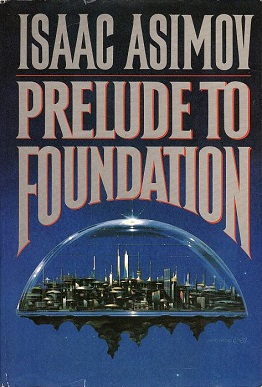
Prelude to Foundation is a novel by American writer Isaac Asimov, published in 1988. It is one of two prequels to the Foundation series. For the first time, Asimov chronicles the fictional life of Hari Seldon, the man who invented psychohistory and the intellectual hero of the series. The novel was nominated for the Locus Award.
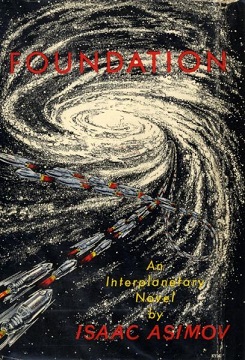
The Foundation series is a science fiction book series written by American author Isaac Asimov. First published as a series of short stories and novellas in 1942–50, and subsequently in three collections in 1951–53, for nearly thirty years the series was a trilogy: Foundation (1951); Foundation and Empire (1952); and Second Foundation (1953). It won the one-time Hugo Award for "Best All-Time Series" in 1966. Asimov later added new volumes, with two sequels: Foundation's Edge (1982) and Foundation and Earth (1986), and two prequels: Prelude to Foundation (1988) and Forward the Foundation (1993).

Hari Seldon is a fictional character in the Foundation series of novels by Isaac Asimov. In his capacity as mathematics professor at Streeling University on the planet Trantor, Seldon develops psychohistory, an algorithmic science that allows him to predict the future in probabilistic terms. On the basis of his psychohistory he is able to predict the eventual fall of the Galactic Empire and to develop a means to shorten the millennia of chaos to follow.

R. Daneel Olivaw is a fictional robot created by Isaac Asimov. The "R" initial in his name stands for "Robot," a naming convention in Asimov's future society during Earth's early period of space colonization. Daneel is introduced in The Caves of Steel, a serialized story published in Galaxy Science Fiction from October to December 1953. The full story was published by Doubleday as a hardcover book in 1954.

Second Foundation is the third novel published of the Foundation Series by American writer Isaac Asimov, and the fifth in the in-universe chronology. It was first published in 1953 by Gnome Press.
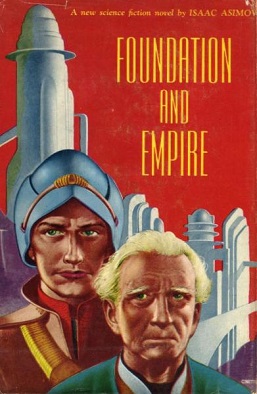
Foundation and Empire is a science fiction novel by American writer Isaac Asimov originally published by Gnome Press in 1952. It is the second book in the Foundation series, and the fourth in the in-universe chronology. It takes place in two parts, originally published as separate novellas. The second part, "The Mule," won a Retro Hugo Award in 1996.
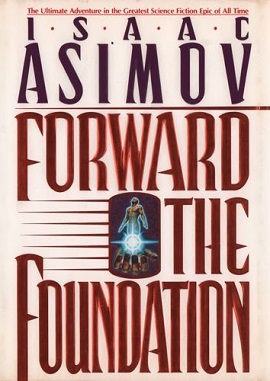
Forward the Foundation is a novel by American writer Isaac Asimov, published posthumously in 1993. It is the second of two prequels to the Foundation Series. It is written in a format similar to that of the original book, Foundation, composed of chapters with long intervals in between, although Forward takes place within only one lifetime. Both books were first published as independent short stories in science fiction magazines.
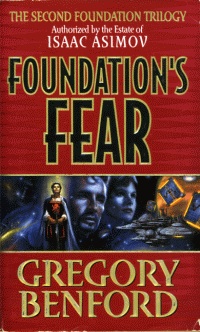
Foundation's Fear (1997) is a science fiction novel by American writer Gregory Benford, set in Isaac Asimov's Foundation universe. It is the first book of the Second Foundation Trilogy, which was written after Asimov's death by three authors, authorized by the Asimov estate.

Foundation's Triumph (1999) is a science fiction novel by American writer David Brin, set in Isaac Asimov's Foundation universe. It is the third book of the Second Foundation trilogy, which was written after Asimov's death by three authors, authorized by the Asimov estate. Brin synthesizes dozens of Foundation-Empire-Robots novels and short stories by Isaac Asimov, Roger MacBride Allen, and authorized others into a consistent framework. Foundation's Triumph includes an appendix chronology compiled by Attila Torkos.
Psychohistory is a fictional science in Isaac Asimov's Foundation universe which combines history, sociology, and mathematical statistics to make general predictions about the future behavior of very large groups of people, such as the Galactic Empire. It was first introduced in the four short stories (1942–1944) which would later be collected as the 1951 novel Foundation.
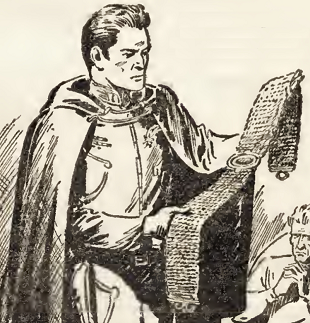
Bel Riose is a fictional character in the Foundation series by Isaac Asimov. In the 1945 novella "Dead Hand", he is the last great general of the declining Galactic Empire. He targets the Foundation both as a perceived threat to the Empire and to further his own ambitions, but is outmaneuvered by its agents.

The Galactic Empire is an interstellar empire featured in Isaac Asimov's Robot, Galactic Empire, and Foundation series. The Empire is spread across the Milky Way galaxy and consists of almost 25 million planets settled exclusively by humans. For over 12 millennia the seat of imperial authority was located on the ecumenopolis of Trantor, whose population exceeded 40 billion, until it was sacked in the year 12,328. The official symbol of the empire is the Spaceship-and-Sun. Cleon II was the last Emperor to hold significant authority. The fall of the empire, modelled on the fall of the Roman Empire, is the subject of many of Asimov's novels.

Salvor Hardin is a fictional character in the Foundation series by Isaac Asimov. Introduced in the 1942 short story "Foundation", he is the first mayor of Terminus, the home planet of the Foundation. He defuses a potential political crisis with four nearby barbarian planets, while also securing their dependence on the Foundation. Hardin takes advantage of this power in "Bridle and Saddle" (1942) when one of the planets, Anacreon, declares war on the Foundation.

Hober Mallow is a fictional character in the Foundation series by Isaac Asimov. In the 1944 novella "The Big and the Little", he is a Master Trader for the Foundation who pioneers the use of commerce to increase the Foundation's power and influence across the galaxy.

Gaal Dornick is a fictional character in the Foundation series by Isaac Asimov. Introduced in Foundation (1951), he is a gifted young mathematician from a remote world who becomes embroiled in the conflict surrounding famed mathematician and psychologist Hari Seldon and his predictive science of psychohistory.
Isaac Asimov's The Foundation Trilogy was adapted for the BBC Radio 4 in eight hour-long episodes by Patrick Tull and Mike Stott, directed by David Cain, first broadcast in 1973, and repeated in 1977 and 2002.
The Foundation universe is the future history of humanity's colonization of the galaxy, spanning nearly 25,000 years, created through the gradual fusion of the Robot, Galactic Empire, and Foundation book series written by American author Isaac Asimov.
Foundation is an American science fiction television series created by David S. Goyer and Josh Friedman for Apple TV+, loosely based on the Foundation series of stories by Isaac Asimov. It features an ensemble cast led by Jared Harris, Lee Pace, Lou Llobell and Leah Harvey. The series premiered on September 24, 2021. In October 2021, the series was renewed for a second season, which premiered on July 14, 2023. In December 2023, the series was renewed for a third season.

Demerzel is a fictional character in the 2021 Apple TV+ television series Foundation, an adaptation of the Foundation series of novels by Isaac Asimov. She is portrayed by Finnish actress Laura Birn. Demerzel is a gynoid, or female-presenting humanoid robot, who serves as the majordomo to the revolving trio of Emperor Cleon clones, Brothers Dawn, Day and Dusk. In season two, it is revealed that Demerzel is the real power behind the Imperial throne, guiding humanity on a millennial scale.















